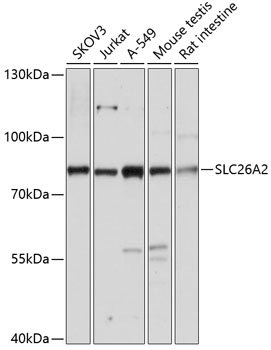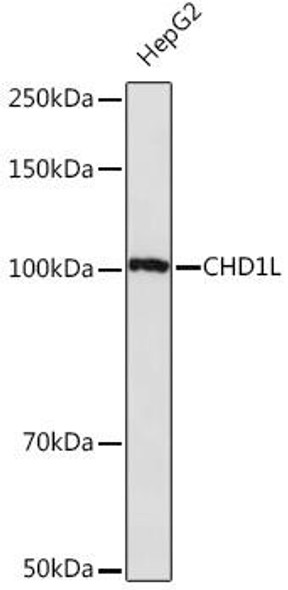Anti-SLC26A2 Antibody (CAB14561)
- SKU:
- CAB14561
- Product type:
- Antibody
- Reactivity:
- Human
- Mouse
- Rat
- Host Species:
- Rabbit
- Isotype:
- IgG
- Antibody Type:
- Polyclonal Antibody
- Research Area:
- Signal Transduction
Description
| Antibody Name: | Anti-SLC26A2 Antibody |
| Antibody SKU: | CAB14561 |
| Antibody Size: | 20uL, 50uL, 100uL |
| Application: | WB |
| Reactivity: | Human, Mouse, Rat |
| Host Species: | Rabbit |
| Immunogen: | Recombinant fusion protein containing a sequence corresponding to amino acids 1-111 of human SLC26A2 (NP_000103.2). |
| Application: | WB |
| Recommended Dilution: | WB 1:500 - 1:2000 |
| Reactivity: | Human, Mouse, Rat |
| Positive Samples: | SKOV3, Jurkat, A-549, Mouse testis, Rat intestine |
| Immunogen: | Recombinant fusion protein containing a sequence corresponding to amino acids 1-111 of human SLC26A2 (NP_000103.2). |
| Purification Method: | Affinity purification |
| Storage Buffer: | Store at -20°C. Avoid freeze / thaw cycles. Buffer: PBS with 0.02% sodium azide, 50% glycerol, pH7.3. |
| Isotype: | IgG |
| Sequence: | MSSE SKEQ HNVS PRDS AEGN DSYP SGIH LELQ RESS TDFK QFET NDQC RPYH RILI ERQE KSDT NFKE FVIK KLQK NCQC SPAK AKNM ILGF LPVL QWLP KYDL KKNI LGD |
| Gene ID: | 1836 |
| Uniprot: | P50443 |
| Cellular Location: | Membrane, Multi-pass membrane protein |
| Calculated MW: | 81kDa |
| Observed MW: | 82kDa |
| Synonyms: | SLC26A2, D5S1708, DTD, DTDST, EDM4, MST153, MSTP157 |
| Background: | The diastrophic dysplasia sulfate transporter is a transmembrane glycoprotein implicated in the pathogenesis of several human chondrodysplasias. It apparently is critical in cartilage for sulfation of proteoglycans and matrix organization. |
| UniProt Protein Function: | SLC26A2: Sulfate transporter. May play a role in endochondral bone formation. Defects in SLC26A2 are the cause of diastrophic dysplasia (DTD). DTD is an autosomal recessive disease characterized by osteochondrodysplasia with clinical features including dwarfism, spinal deformation, and specific joint abnormalities. Defects in SLC26A2 are the cause of achondrogenesis type 1B (ACG1B). ACG1B is a recessively inherited chondrodysplasia characterized by extremely poor skeletal development and perinatal death. Defects in SLC26A2 are the cause of atelosteogenesis type 2 (AO2); also known as neonatal osseous dysplasia 1. AO2 is characterized by severely shortened limbs, small chest, scoliosis, club foot of the equinovarus type (talipes equinovarus), abducted thumbs and great toes, and cleft palate. Patients die of respiratory insufficiency shortly after birth because of the collapse of the airways and pulmonary hypoplasia due to the small rib cage. Defects in SLC26A2 are the cause of multiple epiphyseal dysplasia type 4 (EDM4). EDM is a generalized skeletal dysplasia associated with significant morbidity. Joint pain, joint deformity, waddling gait, and short stature are the main clinical signs and symptoms. EDM is broadly categorized into the more severe Fairbank and the milder Ribbing types. EDM4 is a recessively inherited form, characterized by early childhood-onset hip dysplasia and recurrent patella dislocation. Short stature in EDM4 patients is not frequent. Belongs to the SLC26A/SulP transporter (TC 2.A.53) family. |
| UniProt Protein Details: | Protein type:Transporter, SLC family; Membrane protein, multi-pass; Transporter; Membrane protein, integral Chromosomal Location of Human Ortholog: 5q31-q34 Cellular Component: membrane; integral to plasma membrane; plasma membrane Molecular Function:sulfate transmembrane transporter activity; secondary active sulfate transmembrane transporter activity Biological Process: ossification; glycosaminoglycan metabolic process; xenobiotic metabolic process; carbohydrate metabolic process; sulfate transport; ion transport; pathogenesis; transmembrane transport; 3'-phosphoadenosine 5'-phosphosulfate metabolic process; 3'-phosphoadenosine 5'-phosphosulfate biosynthetic process Disease: Atelosteogenesis, Type Ii; Diastrophic Dysplasia; Achondrogenesis, Type Ib; Epiphyseal Dysplasia, Multiple, 4 |
| NCBI Summary: | The diastrophic dysplasia sulfate transporter is a transmembrane glycoprotein implicated in the pathogenesis of several human chondrodysplasias. It apparently is critical in cartilage for sulfation of proteoglycans and matrix organization. [provided by RefSeq, Jul 2008] |
| UniProt Code: | P50443 |
| NCBI GenInfo Identifier: | 254763328 |
| NCBI Gene ID: | 1836 |
| NCBI Accession: | P50443.2 |
| UniProt Secondary Accession: | P50443,Q6N051, A8K2U3, B2R6J1, |
| UniProt Related Accession: | P50443 |
| Molecular Weight: | 739 |
| NCBI Full Name: | Sulfate transporter |
| NCBI Synonym Full Names: | solute carrier family 26 (anion exchanger), member 2 |
| NCBI Official Symbol: | SLC26A2 |
| NCBI Official Synonym Symbols: | DTD; EDM4; DTDST; MST153; D5S1708; MSTP157 |
| NCBI Protein Information: | sulfate transporter; sulfate anion transporter 1; diastrophic dysplasia protein; solute carrier family 26 (sulfate transporter), member 2 |
| UniProt Protein Name: | Sulfate transporter |
| UniProt Synonym Protein Names: | Diastrophic dysplasia protein; Solute carrier family 26 member 2 |
| Protein Family: | Sulfate transporter |
| UniProt Gene Name: | SLC26A2 |
| UniProt Entry Name: | S26A2_HUMAN |









